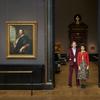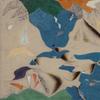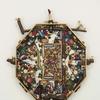Major New Exhibition from King's College London Features 3 International War Artists
- LONDON, United Kingdom
- /
- September 27, 2016
■ Traces of War is a major new exhibition from King’s College London. It is the result of collaborations between The Department of War Studies at King’s and three international artists.
■ As the ‘everyday’ of battle is brought into the gallery space, Traces of War hopes to represent the paradoxical dynamic of war and the everyday - its enduring imprint upon both the body politic and the subject of international relations
■ Working primarily with photography, film and multimedia installations, all three artists have direct experience of conflict and war zones, from Iraq to India, Bangladesh to Afghanistan
We see war in all kinds of spaces and locations, some predictable and others less so. The elements of war are present in our everyday lives, in our daily routines; from violence, antagonisms, discourses of exclusion, displacements and populations on the move. There is a resonance in Michel Foucault’s observation that the ‘roar of battle’ travels silently in our modes of being and interactions, discourses and institutions, and the practices we take for granted.
Artists throughout history have sought to capture the agony of war, its impact on combatants and civilians, on landscapes, and on the most hidden spaces: our memories, identities, and lived experiences. At the same time, the phenomenon of war
is not confined to moments of crisis or battlefield locations. War should not be something defined by its representation on screens or in print where narratives of patriotism distort, but rather should be seen as a force which disrupts the normality of everyday life, ever present both viscerally and emotionally.
Traces of War, curated by Cécile Bourne-Farrell and Vivienne Jabri , Professor of International Relations, King’s College London, reimagines war beyond its exceptionality, locating it in spaces where it would be least expected . At the same
time, the artworks and artists reveal the sheer power of the everyday, as life in its own right and at its most ordinary makes its presence felt in the most dangerous war zones. In Traces of War, three internationally renowned artists, Jananne Al-Ani, Baptist Coelho and Shaun Gladwell, expose the more quotidian side of warfare.
Working primarily with photography, film and multimedia installations, all three artists have direct experience of conflict and war zones. As such, from their respective experiences in Iraq, India, Bangladesh or Afghanistan, all three are sensitive to traces of war and their residual effects in the domestic sphere.
Born in Kirkuk, Iraq, London based artist, Jananne Al-Ani, reveals war’s presence in seemingly unexpected places while simultaneously depicting its history. Al-Ani presents Shadow Sites II (2011) in which aerial views of archaeological sites prevail, in addition to a new digital video work, Shadow Sites III (2016) , which will be shown for the first time. Al-Ani’s work suggests war’s imprint upon a surface that is only comprehensible in terms of what lies underneath. Since it was using aerial surveillance techniques which prompted the origin of surveillance in archaeology, the two practices are intrinsically linked. It is this intersection between practices which reminds us that there is an inherent tension between what seemingly appears on the surface and what has survived beneath. By using aerial imagery to marry excavation with explosion and
drone warfare, Al-Ani ensures we never forget that what lies underneath the targeted terrain can re-emerge at any time, and with full force.
Indian artist, Baptist Coelho is the current Leverhulme Artist-in-Residence at the Department of War Studies, King’s College London. While Al-Ani transports her audience to sites of conflict and warfare through aerial imagery, Coelho adopts a
different stance to the ‘everyday’ of battle as he brings what he refers to as the ‘fabrics’ of war into the physical grasps of his audience. In Nowhere but here a large soft sculpture is made of Siachen soldiers’ thermal clothing. These fabrics are the literal materials of a life lived in battle zones recycled to form the canopy of a parachute.
Soldiers’ uniforms personify the solitary experiences of soldiers in static warfare against extreme conditions of India’s farthest mountain reaches. Coelho’s aim is to reveal the paradox of heroism, where more lives are lost due to extreme cold
temperatures than the army bullet. His combined use of these objects with fabrics and gestures accentuates the simplicity of what is, put simply, very human. Blueys, Coelho’s never before seen epistolary installation, promotes this humanism through its juxtaposition of personal letters with rigid Government-issued Language cards. The dialogue between a British soldier with his wife is positioned side by side with the formal relationship between the English and Arabic languages; both differing in their representation of geographical divides.
Australian-born artist Shaun Gladwell , who served as Australia’s official war artist in the first Gulf War and later in Afghanistan, uses his photography to critically analyse the use of cameras and filmography in warfare. Double Field/Viewfinder (Tarin Kowt) was produced during the artist's tenure in Afghanistan and is the first work to use the
medium of video in the history of the scheme, the moving image lending itself to explorations in the role of technology, communications and surveillance, in contemporary warfare. A synchronised dual-channel video, televised on two screens
facing one another, presents two soldiers stood in the Afghan desert. These two figures, rendered in slow-motion, are caught in a standoff as they simultaneously circle, imitate and shoot one another with their hand-held cameras. The materials of war are here revealed in the landscape, in soldiers’ helmets, modern warfare against ancient terrains and in their corporeal movement. Coelho’s preoccupation with an untheatrical war is mimicked in the human focus of Gladwell’s photographs. Where for Coelho, materials straddle both the military and the domestic sphere, in Gladwell’s photography and video, it is the camera which in retaining situational elements of the body destabilizes the time and space of war.
The three artists invite exploration into the academic research facilitated by The Department of War Studies. It is this intersection of war with the everyday, as well as the artists’ own direct encounters with war, that render it both comprehensible and strange.
In addition to the exhibition, The Department of War Studies at King’s will contextualise the works in a four day Symposium and work with young people, war veterans, students and the public through a collaborative series of dance workshops
culminating in public performance. There will also be an exhibition catalogue with selected essays and commentary.






![Peter Paul Rubens (Flemish, 1577–1640), After Titian (Tiziano Vecelli) (Italian [Venetian], c. 1488–1576), Rape of Europa, 1628–29. Oil on canvas, 71 7/8 x 79 3/8 in. Peter Paul Rubens (Flemish, 1577–1640), After Titian (Tiziano Vecelli) (Italian [Venetian], c. 1488–1576), Rape of Europa, 1628–29. Oil on canvas, 71 7/8 x 79 3/8 in.](/images/c/e2/2e/Jan20_Rape_of_Europa100x100_c.jpg)

__2016_100x100_c.jpg)







